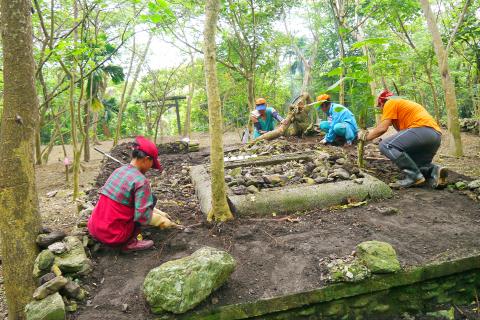People from an Aboriginal community in Hualien have been restoring an abandoned Shinto shrine, built during the Japanese colonial era, in an effort to reconstruct a past forcefully erased from history.
Payi, a senior member of the Qowgan (加灣) community of Truku people in the county’s Sioulin Township (秀林), said: “Restoring Qowgan Shrine is not to re-enact historical trauma, but to recover an unforgettable piece of collective memory dear to the [Truku] people.”
As part of a Japanese expansionist doctrine to exploit colonial resources in Southeast Asia, the then-Japanese government began the Kominka movement in Taiwan in 1936 to Japanize Taiwanese by asking them to worship at Shinto shrines and observe Shinto rituals at home.

Photo: Wang Chun-chi, Taipei Times
A campaign was carried out to set up a Shinto shrine in every town, and many shrines were erected in Aboriginal communities across Taiwan.
The Japanese left Taiwan in 1945 following Japan’s surrender in World War II, and the Chinese Nationalist Party (KMT) government retreated to Taiwan in 1949 after losing the Chinese Civil War.
Most Shinto shrines were either demolished or fell into disrepair after the Ministry of the Interior announced the removal of structures associated with the Japanese regime in 1974, two years after Japan severed diplomatic ties with Taiwan in 1972.
Qowgan Community Association director Kao Wei-ning (高維寧) said the Qowgan Shrine, built in 1938, was abandoned to the same fate and had been left unattended since the KMT government decree.
She said she volunteered to lead the community to preserve the shrine, and that the community would apply to the Council of Indigenous Peoples for a subsidy to rebuild the structure and recreate a forgotten past.
To preserve the ruins, the community has refrained from machine-aided excavation, instead digging the buried structures using only hand tools, she said, adding that the excavation has proceeded to the main hall of the shrine.
The shrine is to be reconstructed in accordance with the seniors’ accounts, and the community hopes that they can also recreate the sacredness and tranquility that used to encompass the shrine, she said.
The 83-year-old Payi said he used to steal glances at Shinto priests where a decrepit torii — a structure marking the entrance to a Shinto shrine — stands, and the sight of a priest, in tailing white robe and a peaked black cap, had terrified him.
Although the Truku people hold a different belief to Shinto, the shrine should be preserved to commemorate that episode of history unique to the community, he said.
Historian Huang Chia-jung (黃家榮) said there are nearly 60 Shinto shrines in Hualien, and the Qowgan Shrine, with its torii, worship hall, main hall’s altar and stone fences around the main hall still remaining, is the most completely preserved shrine among those built in Aboriginal communities and is worthy of preservation.
He said he was greatly moved to see that the Qowgan community volunteered to restore Qowgan Shrine, which he hopes could attract more assistance with their reconstruction efforts, as well as a renewed recognition of history between the Aborigines and Japanese.

US climber Alex Honnold is to attempt to scale Taipei 101 without a rope and harness in a live Netflix special on Jan. 24, the streaming platform announced on Wednesday. Accounting for the time difference, the two-hour broadcast of Honnold’s climb, called Skyscraper Live, is to air on Jan. 23 in the US, Netflix said in a statement. Honnold, 40, was the first person ever to free solo climb the 900m El Capitan rock formation in Yosemite National Park — a feat that was recorded and later made into the 2018 documentary film Free Solo. Netflix previewed Skyscraper Live in October, after videos

Starting on Jan. 1, YouBike riders must have insurance to use the service, and a six-month trial of NT$5 coupons under certain conditions would be implemented to balance bike shortages, a joint statement from transportation departments across Taipei, New Taipei City and Taoyuan announced yesterday. The rental bike system operator said that coupons would be offered to riders to rent bikes from full stations, for riders who take out an electric-assisted bike from a full station, and for riders who return a bike to an empty station. All riders with YouBike accounts are automatically eligible for the program, and each membership account

A classified Pentagon-produced, multiyear assessment — the Overmatch brief — highlighted unreported Chinese capabilities to destroy US military assets and identified US supply chain choke points, painting a disturbing picture of waning US military might, a New York Times editorial published on Monday said. US Secretary of Defense Pete Hegseth’s comments in November last year that “we lose every time” in Pentagon-conducted war games pitting the US against China further highlighted the uncertainty about the US’ capability to intervene in the event of a Chinese invasion of Taiwan. “It shows the Pentagon’s overreliance on expensive, vulnerable weapons as adversaries field cheap, technologically

NUMBERs IMBALANCE: More than 4 million Taiwanese have visited China this year, while only about half a million Chinese have visited here Beijing has yet to respond to Taiwan’s requests for negotiation over matters related to the recovery of cross-strait tourism, the Tourism Administration said yesterday. Taiwan’s tourism authority issued the statement after Chinese-language daily the China Times reported yesterday that the government’s policy of banning group tours to China does not stop Taiwanese from visiting the country. As of October, more than 4.2 million had traveled to China this year, exceeding last year. Beijing estimated the number of Taiwanese tourists in China could reach 4.5 million this year. By contrast, only 500,000 Chinese tourists are expected in Taiwan, the report said. The report